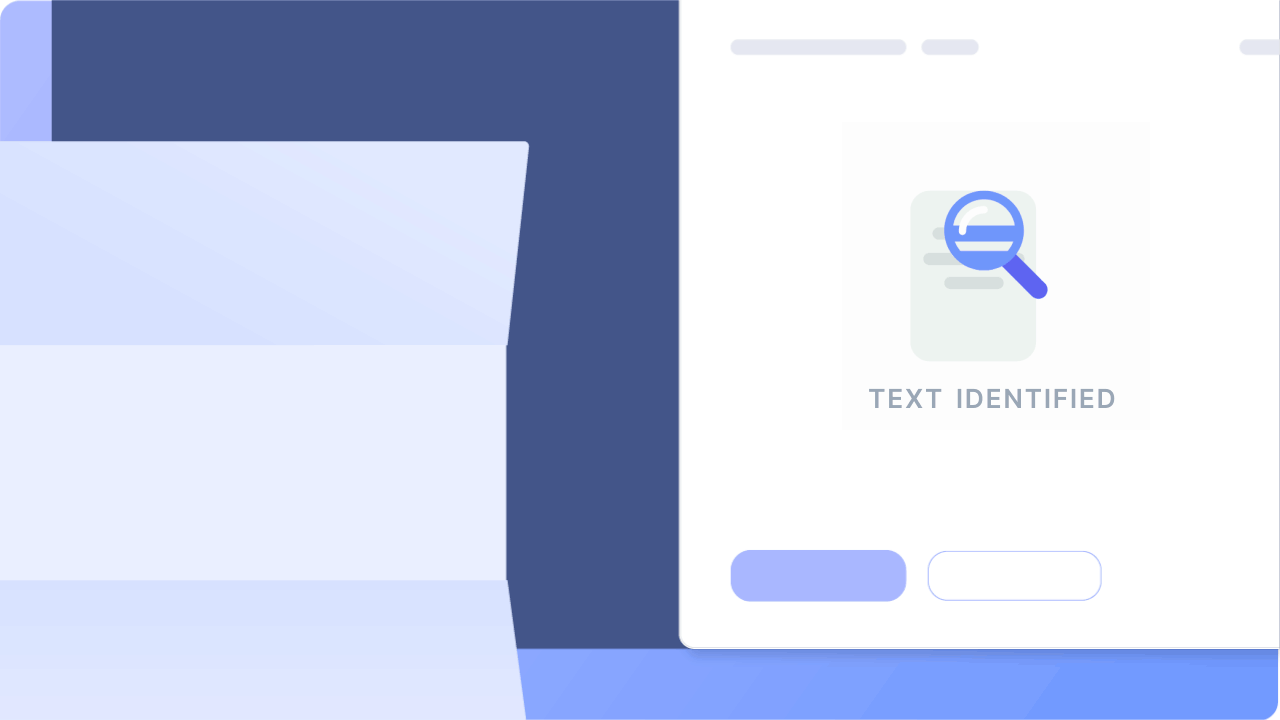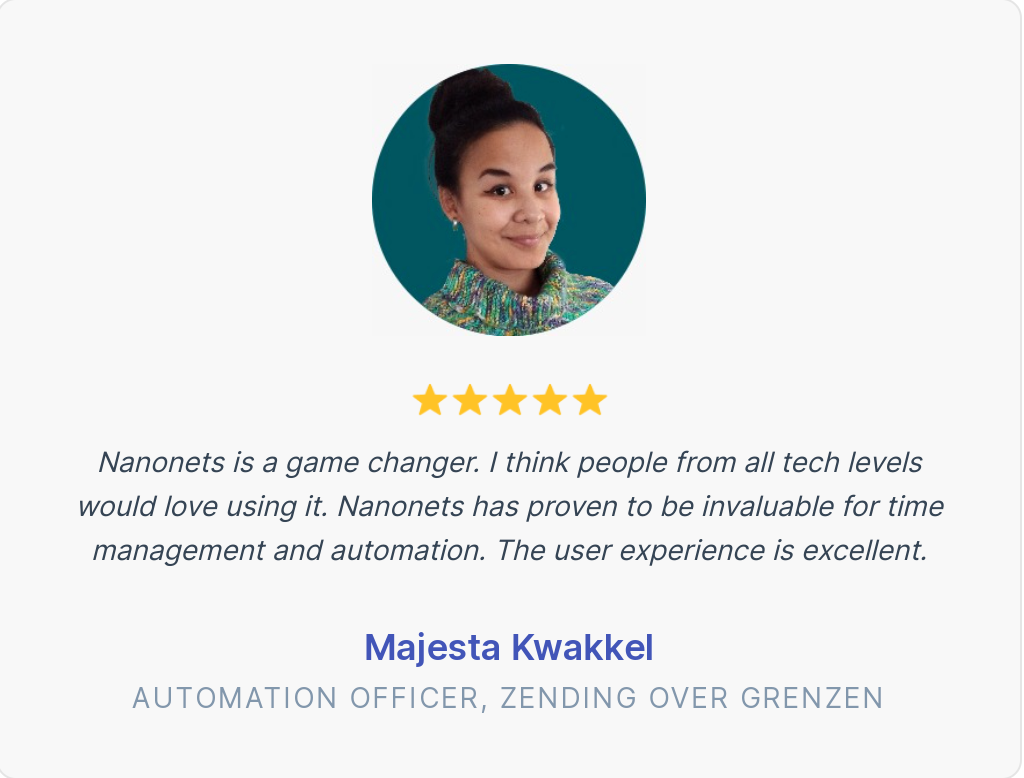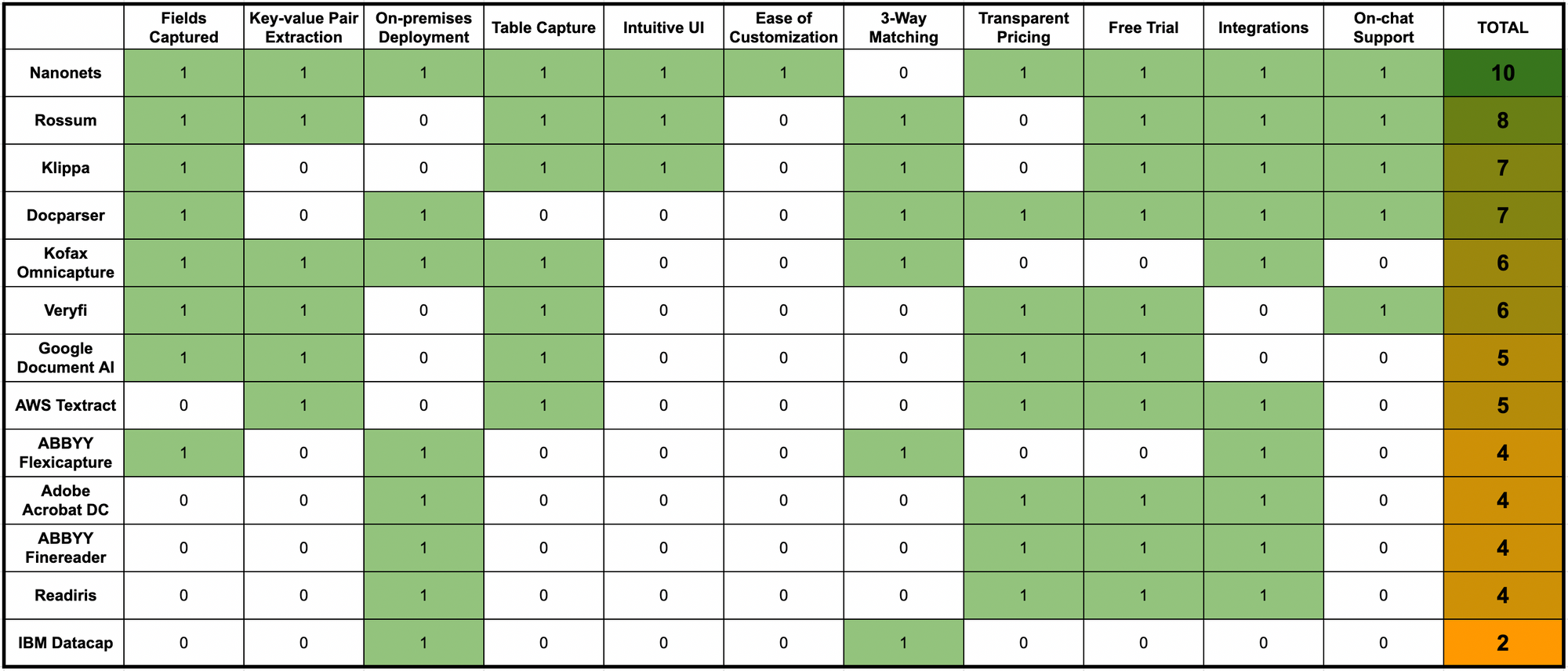What Is The Best Text Scanning Service?
Optical character recognition (OCR) software help convert non-editable document formats such as PDFs, images or paper documents into machine-readable formats that are editable & searchable.
OCR applications are commonly used to capture text from PDFs & images and convert the text into editable formats such as Word, Excel or a obviously text file. OCR is also used to digitise files and documents to make them searchable.
OCR software leveraging AI/ML capabilities tin also help automate information capture from scanned documents/images. AI-based OCR can digitize the information in convenient, editable formats that fit into organizational workflows.
Scanning & processing documents such as invoices, receipts, and images for valuable information has traditionally been a transmission process fraught with errors and delays. OCR software solutions assistance businesses save time and resources that would otherwise be spent on information entry & manual validation/verification.
More than and more organizations are automating certificate processing workflows to become paperless and leverage deject-based digital solutions that ameliorate bottom lines.
Let's take a look at the nearly popular OCR software in 2022 & besides check out some complimentary OCR software.
Automate manual data entry using Nanonet's AI-based OCR software. Capture data from documents instantly. Reduce turn effectually times and eliminate transmission effort.

Tabular array of Contents
- What is OCR & what does OCR software exercise?
- What is the best OCR software out in that location?
- Nanonets
- ABBYY Flexicapture
- ABBYY Finereader
- Kofax Omnipage
- IBM Datacap
- Google Document AI
- AWS Textract
- Docparser
- Adobe Acrobat DC
- Klippa
- How Nanonets stands apart as an OCR software?
- Is there whatever gratis OCR software?
What is OCR & what does OCR software exercise?
OCR or Optical Character Recognition is a engineering that identifies & recognizes text within scanned documents, photos or images. OCR software leverages this engineering science to extract data from PDFs or scanned documents by converting it into motorcar-readable text data that can be edited & stored more than conveniently for farther processing. For a detailed explainer on OCR and its use cases refer to this guide.
OCR is also used in various other use cases such every bit extracting tables from PDFs, extracting text from images or extracting text from PDFs or other non-editable formats.
Today, OCR software is used for automated data entry, pattern recognition, text-to-speech services, indexing documents for search engines, cognitive computing, text mining, key data and auto translation amidst various other applications. These tools can catechumen any scanned documents, PDFs or image types into xml, xlsx or csv files.
The best OCR Software for your business
Let's await at some of the best OCR software available on the market.
Nanonets

Nanonets is an AI-based OCR software that automates data capture for intelligent document processing of invoices, receipts, ID cards and more. Nanonets uses advanced OCR, machine learning image processing, and Deep Learning to excerpt relevant information from unstructured data. Information technology is fast, accurate, easy to use, allows users to build custom OCR models from scratch and has some bully Zapier integrations. Digitize documents, extract data-fields, and integrate with your everyday apps via APIs in a uncomplicated, intuitive interface.
How does Nanonets stand up apart as an OCR software?
Pros:
- Modern UI
- Handles large volumes of documents
- Reasonably priced
- Ease of utilise
- Cognitive capture of information - resulting in minimal intervention
- Requires no in-business firm team of developers
- Algorithm/models can be trained/retrained
- Nifty documentation & support
- Lots of customization options
- Wide choice of integration options
- Works with not-English or multiple languages
- Well-nigh no mail service-processing required
- Seamless two-way integration with multiple accounting software
- Dandy OCR API for developers
Cons:
- Can't handle very loftier volume spikes
- Table capture UI can be improve
Get started with Nanonets' pre-trained OCR extractors or build your own custom OCR models. You can also schedule a demo to acquire more than most our OCR utilize cases!

ABBYY Flexicapture
FlexiCapture is a stable, scalable document imaging and information extraction software that automatically transforms documents of any structure, linguistic communication or content into usable and attainable business organisation-ready data.
Pros:
- Recognizes images very well
- Like shooting fish in a barrel to shop difficult copy result in arrangement
- Integrates well with ERP systems
- Automates data extraction from documents (to an extent)
Cons:
- Initial setup can exist difficult and complex
- Automatic processing of invoices non fix
- No set up-fabricated templates
- Difficult to customize
- No resources bachelor
- Could accept amend integration with RPA solutions
- Low accurateness with low resolution images/documents
- Batch verifications are held up even if there's an fault but in a particular section
- Line particular error letters popular upwards even for items that should be skipped
- RESTful API is not available in the on-prem version
ABBYY Finereader
ABBYY FineReader PDF is an OCR software with back up for PDF file editing. The program allows the conversion of image documents into editable electronic formats.
Pros:
- Keyboard-friendly OCR editor for manual corrections
- Uncommonly clear interface
- Exports to multiple formats
- Unique document-compare feature
Cons:
- Lacks full-text indexing for fast searches
- Requires a learning curve
- Pricing can exist prohibitive
- Inability to view the history of document changes
- Can't merge several files into ane
- Might require some post-processing
- The UI could be overwhelming at first
- Irksome to process big files
Need an OCR software for image to text extraction or PDF data extraction? Looking to convert PDF to table, or PDF to text? Check out Nanonets in action!
Kofax Omnipage
Omnipage is a powerful PDF OCR software that can handle automation for loftier-volume corporate OCR tasks. This tool specialises in table extraction, line item matching, and smart extraction.
Pros:
- Has a robust set of tools for enhancing images
- Highly accurate
Cons:
- UI not intuitive
- Configuration for AP Automation is not straightforward
- API integration can be improved
IBM Datacap
Datacap streamlines the capture, recognition and classification of business documents to extract important information from them. Datacap has a strong OCR engine, multiple functions as well as customisable rules. It works across multiple channels, including scanners, mobile devices, multifunction peripherals and fax.
Pros:
- Configures complex applications in data capture
- Scanning mechanism
- Ease of apply
Cons:
- Very little online support
- UI could be more intuitive
- Setup can be cumbersome
- Slow
- Creating a customized menses isn't straightforward
- Batch commits take fourth dimension
Start using Nanonets for Automation. Attempt out the diverse OCR models or request a demo today. Find out how Nanonets' utilize cases tin can employ to your product.
Google Document AI
One of the solutions in the Google Cloud AI suite, the Document AI (DocAI) is a certificate processing console that uses machine learning to automatically classify, extract, enrich data and unlock insights inside documents.
Pros:
- Piece of cake to set
- Integrates very well with other Google services
- Storage of information
- Speed
Cons:
- AI modules lack proper documentation
- Customization of existing modules and libraries is hard
- Not suited for Python or other coding languages
- Outdated API documentation
- Expensive
- Not suited for hybrid cloud deployments
- Not suited for use cases that require custom AI algorithms
AWS Textract automatically extracts text and other data from scanned documents using machine learning and OCR. It is likewise used to place, sympathize, and excerpt information from forms and tables. For more data cheque out this detailed breakdown of AWS Textract.
Pros:
- Pay-per-use billing model
- Ease of utilise
Cons:
- Can't be trained
- Varying accuracy
- Not meant for handwritten documents
Want to scrape information from PDF documents, convert PDF tabular array to Excel or automate table extraction? Check out Nanonets PDF scraper or PDF parser to scrape PDF data or parse PDFs at scale!
Docparser
Docparser is a cloud-based certificate processing and OCR software that can automate low-value tasks and workflows for businesses.
Pros:
- Easy setup
- Zapier integration
Cons:
- The webhooks occasionally fail
- Requires some bargain of preparation to option upwardly the parsing rules
- Not enough templates
- Zonal OCR approach - can't handle unknown templates
- UI could be better
- Ho-hum to load pages
- Documentation could be better
Adobe Acrobat DC
Adobe provides a comprehensive PDF editor with an in-built OCR functionality.
Pros:
- Stability/compatibility.
- Ease of use
Cons:
- Expensive
- Not an exclusive OCR software
- Heavy on the system
- Takes up a lot of space on the hd
- Difficult to integrate with services like Sharepoint or Dropbox
- Requires an Adobe Creative Cloud license.
Klippa
Klippa provides automated document management, processing, classification and information extraction solutions to digitize paper documents in your arrangement.
Pros:
- Fast setup
- Great back up
- Great API for developers
- Articulate and concise API documentation
- Links well with accounting programs
- Competitively priced
- Integrations
Cons:
- OCR recognition tin exist ameliorate
- Limited template customizations
- Limited white-characterization customizations
- Bulk adjustments non supported
- The VAT is oft not displayed correctly
- The app crashes often
- Tin can't train the OCR model
- The selection process isn't straightforward as at that place are a lot of options
Nanonets OCR API has many interesting employ cases t hat could optimize your business functioning, save costs and boost growth. Discover out how Nanonets' apply cases can employ to your product.
Other notable mentions include Veryfi, Readiris, Infrrd, Rossum & Hypatos.
Hither'due south a quick comparing of all the OCR software listed above across some crucial OCR software features & parameters:

How does Nanonets stand autonomously equally an OCR software?
Nanonets OCR software is easy and flexible to set up up, requiring simply well-nigh 1 mean solar day. The automation handles unstructured information without much difficulty and the AI also handles common data constraints with ease. Information from documents with imperfections & blemishes is extracted quite hands. It handles multi-page invoices and identifies multi-line items with ease; something that nearly legacy and modern OCR tools fail at. Nanonets customizes column headers allowing information technology to process complex invoices more than efficiently. Nanonets' AI also ensures a loftier accurateness while processing documents requiring minimal rework or revision.
The benefits of using Nanonets go merely across better accuracy, experience and scalability. Here are 8 reasons that highlight the unique Nanonets advantage:
- Training & working with custom data - Most OCR software out there are quite rigid on the type of information they can piece of work with. Nanonets isn't bound by such limitations. Nanonets uses your own data to train models that are best suited to come across the particular needs of your business organisation.
- Easy to use & flexible - Adapting Nanonets for your specific business organization needs is like shooting fish in a barrel and straightforward. From creating custom OCR models & retraining them to adding new fields & treatment integrations, Nanonets tin handle it all.
- Learns & retrains continuously - Businesses often confront dynamically changing requirements and needs. To overcome potential roadblocks, Nanonets OCR software allows y'all to easily re-train your models with new data. This allows your OCR model to adapt to unforeseen changes.
- Customize, customize, customize - Nanonets tin capture as many fields of text/information that you like and present information technology in any desired fashion. Captured data tin can be presented in tables or line items or whatsoever other format of your selection with custom validation rules. Always retrieve that Nanonets is not bound by the template of your certificate!
- Requires almost no postal service-processing - While most OCR software just grab and dump data, Nanonets extracts only the relevant information and automatically sorts them into intelligently structured fields making it easier to view and sympathize. This does abroad with a lot of time spent in revision and verification.
- Handles mutual data constraints with ease - Nanonets leverages deep learning & object detection techniques to overcome common information constraints that greatly affect text recognition and extraction among other OCR software. Nanonets AI can recognize and handle handwritten text, images with low resolution, images with new or cursive fonts and varying sizes, images with shadowy text, tilted text, random unstructured text, image noise, blurred images and more. Traditional OCR software are simply not equipped to perform under such constraints; they crave data at a very high level of allegiance which isn't the norm in real life scenarios.
- Works with non-English or multiple languages - Since Nanonets focuses on training with custom data, it is uniquely placed to build a single model that could excerpt text from documents in any language or multiple languages at the same fourth dimension.
- Requires no in-firm team of developers - No need to worry about hiring developers and acquiring talent to personalize Nanonets API for your business requirements. Nanonets was built for hassle-complimentary integration. You lot can readily integrate Nanonets with most CRM, ERP, content services or RPA software.
Is there any free OCR software?
Autonomously from the professional cutting-edge OCR solutions mentioned above, there are free OCR software that do the job to an extent. Running on open up-source OCR engines (like Tesseract), these free solutions assist convert photos, PDFs, TIFFs or scanned documents into editable digital text formats. While they might not exist able to process elaborate business documents at scale, they are adequate for extracting text from elementary documents with straightforward formatting.
These gratis OCR solutions either come as web-based applications, standalone software that demand to be installed on various platforms, or as a side feature in a total-fledged certificate editing service. Please annotation that costless OCR software regularly fail to process handwritten documents, multi-cavalcade tables, long line items, or low quality images/scans.
Here are some complimentary optical character recognition tools for your consideration:
- OnlineOCR.net
- FreeOCR.
- SimpleOCR
- GOCR
- Office Lens
- English OCR
- Easy Screen OCR
- A9t9
- Photo Scan
- Capture2Text
- Adobe Browse
- OCR Using Microsoft OneNote
- OCR With Google Docs
Update May 2022: this post was originally published in January 2021 and has since been updated with the latest findings & resources.
Here's a slide summarizing the findings in this article. Hither's an alternating version of this postal service.
What Is The Best Text Scanning Service?,
Source: https://nanonets.com/blog/ocr-software-best-ocr-software/
Posted by: heathhichit.blogspot.com


0 Response to "What Is The Best Text Scanning Service?"
Post a Comment